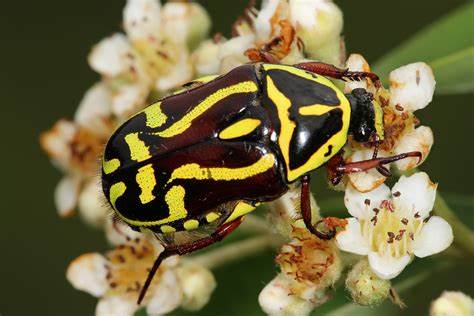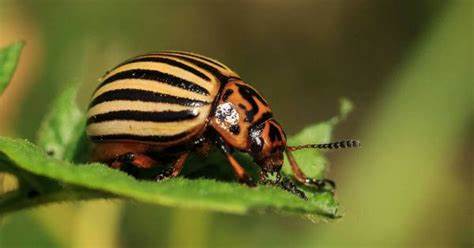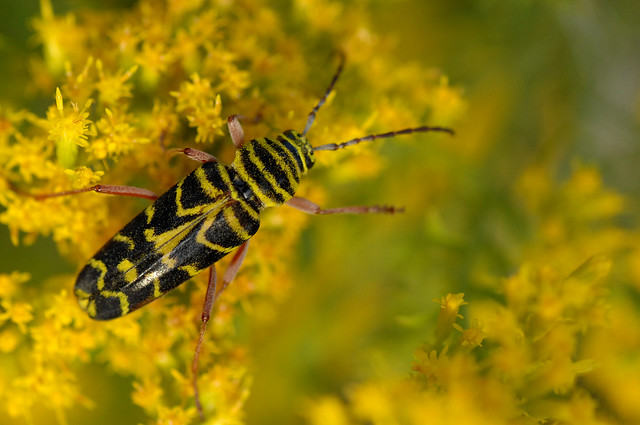You’re going about your day, perhaps enjoying a peaceful evening at home, when suddenly you spot a small, vibrant creature scurrying across your kitchen counter. Its striking yellow and black coloration immediately catches your eye, and you realize you have encountered a yellow and black beetle – a common household pest with a truly unique appearance.
These tiny creatures may seem innocuous at first glance, but their presence in homes can often lead to irritation and unwelcome infestations. Despite being considered pests, yellow and black beetles possess a beauty that sets them apart from other insects that may invade our living spaces.
In this blog post, we will delve into the fascinating world of these beetles, exploring their distinctive characteristics, the types commonly found in households, their lifecycle, ecological role, and practical tips for dealing with infestations.

Characteristics of Yellow and Black Beetles
When it comes to the physical characteristics of yellow and black beetles, they are known for their small to medium size, usually measuring around half an inch to one inch in length. Their bodies are compact and oval-shaped, with a slightly curved shell covering their wings.
This shell, known as the elytra, serves as a protective shield for their delicate hind wings, which they use for flying.
The color patterns and markings on yellow and black beetles are striking and serve both functional and evolutionary purposes. The bright yellow hues often act as a warning sign to potential predators, signaling that the beetle may be toxic or distasteful.
The black markings, which can vary in shape and distribution, create a stark contrast against the yellow background, amplifying the warning effect. These contrasting colors are a form of aposematism, a visual signal used by many insects to deter predators.
The size and shape of yellow and black beetles play a role in their overall agility and mobility. Their compact bodies and six jointed legs allow them to move swiftly and navigate various terrains with ease.
Additionally, their hard exoskeleton provides protection from external threats and helps retain moisture, crucial for their survival in different environments.
Types of Yellow and Black Beetles
In households, several species of yellow and black beetles are commonly encountered, each with distinct habits and behaviors.
The Asian Lady Beetle: known for its vibrant yellow or orange elytra with black spots are one of such species. These beetles are attracted to homes during the cooler months, seeking shelter in warm crevices. While generally harmless, they can release a foul-smelling chemical when threatened.
Carpet Beetle: this is another household pest, characterized by its small size and distinct yellow and black patterning. These beetles feed on natural fibers like wool and carpets, making them a nuisance for homeowners. They are notorious for causing damage to clothing and household fabrics.
Spotted Cucumber Beetle: is another yellow and black beetle that can be found in gardens and agricultural settings. These beetles feed on cucurbit plants and can cause damage to crops. Their coloration serves as a warning to predators, indicating their potential toxicity.
Despite sharing similar color patterns, variations in appearance can be observed among different species of yellow and black beetles. For example, some species may have thinner black stripes or spots, while others may exhibit more intricate patterning on their elytra.
Additionally, size differences can also be noted, with some species being larger or smaller than others within the same color scheme.
In terms of habits and behaviors, yellow and black beetles exhibit a range of activities based on their ecological niche and diet preferences. Some may be scavengers, feeding on decaying matter, while others are herbivores, consuming plant materials.
Understanding the habits and behaviors of these beetles is essential for effective pest management and conservation efforts.

Lifecycle of The Yellow and Black Beetle
The lifecycle of yellow and black beetles typically consists of four main stages: egg, larva, pupa, and adult. During the egg stage, female beetles lay their eggs in suitable environments, such as soil, plants, or crevices within homes.
The eggs hatch into larvae, which are voracious feeders and often the most destructive stage for household infestations. Larvae of yellow and black beetles like Carpet Beetles can cause significant damage to fabrics, furniture, and stored food items.
As the larvae grow and develop, they enter the pupal stage, where they undergo metamorphosis inside a cocoon or protective casing. After the pupal stage, adult beetles emerge ready to reproduce and continue the lifecycle.
Breeding and reproduction habits vary among species, with some beetles mating multiple times while others have specific courtship rituals. Female beetles may lay their eggs in secluded areas that provide food and protection for the developing larvae.
The impact of the beetle lifecycle on infestations in households is significant. Understanding the breeding habits and preferred environments of these beetles is crucial for effective pest control measures.
Regular inspection and maintenance can help identify and eliminate breeding sites, preventing infestations before they escalate. Integrated pest management strategies, including sanitation, sealing entry points, and targeted insecticides, can help manage yellow and black beetle populations within homes.
Ecological Role of Yellow and Black Beetles
Yellow and black beetles play a crucial ecological role in various ecosystems, despite sometimes being considered pests in human environments. These beetles contribute to ecosystem balance and health in several ways:
Decomposition: Many species of yellow and black beetles help break down organic matter, such as dead plants and animals, facilitating the decomposition process. This decomposition role is essential for nutrient cycling in ecosystems, enriching the soil and supporting plant growth.
Pollination: Some beetle species, like flower beetles, play a role in pollination by feeding on flower nectar and transferring pollen between plants. While not as efficient as bees or butterflies, beetles contribute to the pollination of certain plant species, helping maintain biodiversity.
Predation: Certain yellow and black beetle species feed on other insect pests, helping regulate populations of potential agricultural or garden pests. This predatory behavior can be beneficial for natural pest control in ecosystems, reducing the need for chemical interventions.
Soil Health: Beetles like dung beetles contribute to soil health by breaking down fecal matter, aerating the soil, and recycling nutrients back into the ecosystem. Their activities promote soil fertility and support the growth of vegetation.
Despite their beneficial ecological roles, yellow and black beetles can become pests when their populations grow unchecked in human habitats. Understanding the balance between their ecological contributions and their potential impact on human activities is crucial for fostering coexistence.
Integrated pest management approaches that consider both the ecological significance and pest potential of these beetles can help maintain a healthy ecosystem while minimizing conflicts with humans.

Common Infestation Areas in Homes
Yellow and black beetles, such as carpet beetles and ladybugs, are commonly found in various areas within households. Understanding their typical infestation areas, reasons for their presence, and effective prevention and control strategies is essential for managing beetle populations indoors.
Identified Areas
Common infestation areas for yellow and black beetles in homes include:
Carpets and Rugs: Carpet beetles may infest carpets, rugs, and upholstery, where they feed on natural fibers like wool and silk.
Pantry and Kitchen: Beetles like grain beetles and pantry beetles are often found in stored food products, including grains, cereals, and other pantry items.
Windowsills and Entry Points: Ladybugs are attracted to light and warmth, often congregating near windows, doors, and entry points during cooler months.
Garages and Attics: Beetles seeking shelter and warmth may find their way into garages, attics, and crawl spaces, especially in the fall.
Reasons for Presence
Yellow and black beetles are attracted to sources of food, warmth, shelter, and light within homes. They may enter buildings in search of suitable habitats, mating partners, or food sources. Improper storage of food, inadequate sealing of entry points, and lack of regular cleaning can contribute to beetle infestations indoors.
Prevention and Control Strategies
Regular Cleaning: Vacuuming carpets, rugs, and upholstery, and keeping kitchen areas clean and free of food debris can help prevent beetle infestations.
Proper Food Storage: Store pantry items in sealed containers to prevent beetle access and infestation.
Sealing Entry Points: Seal cracks, gaps, and openings around doors, windows, and vents to prevent beetle entry into the home.
Natural Predators: Introducing natural predators like parasitic wasps or predatory beetles can help control beetle populations without using harmful chemicals.
Dealing With Yellow and Black Beetle Infestations
Identifying a yellow and black beetle infestation can be crucial in preventing further damage to your property or garden. Look out for physical signs such as visible beetles, larvae, or holes in plants or wooden structures. Additionally, pay attention to any noticeable damage to foliage or crops, as certain beetles feed on leaves and flowers.
Safe and Effective Removal Techniques
When it comes to safe removal techniques, a good starting point is manual removal. Simply picking off beetles by hand and disposing of them can be effective for smaller infestations. For larger problems, consider using a vacuum cleaner with a hose attachment to suck up beetles without harming your plants.
Natural and Chemical Control Options for Managing Infestations
Natural control options are often favored for managing beetle infestations in an eco-friendly manner. Introducing natural predators like ladybugs, ground beetles, or parasitic wasps can help keep beetle populations in check. Additionally, planting beetle-repelling herbs such as mint, basil, or rosemary around your garden can deter beetles from settling in.
Chemical control options should be considered as a last resort, especially if natural methods have proven ineffective. Insecticidal soaps or neem oil are considered safer alternatives to harsh chemical pesticides and can be effective in controlling beetle infestations.
However, always follow instructions carefully and use protective gear when applying any chemicals.
Crop rotation and practicing good garden hygiene can also help prevent future beetle infestations. Beetles are often attracted to weakened or stressed plants, so ensuring optimal growing conditions for your crops can make them less vulnerable to attacks.
Conclusion
Understanding the unique features of yellow and black beetles helps in identifying and managing infestations. Prompt action is vital to prevent damage and health risks. Seeking professional help for extensive infestations is advisable. Stay informed and proactive to protect your property effectively.
Insecticidal soaps or neem oil are safer alternatives to chemical pesticides. Follow instructions carefully and use protective gear when applying chemicals. Crop rotation and good garden hygiene can prevent beetle infestations.
Optimal growing conditions make crops less vulnerable to attacks. Understanding yellow and black beetles helps in identifying and managing infestations. Prompt action is vital to prevent damage and health risks. Seek professional help for extensive infestations. Stay informed and proactive to protect your property effectively.
